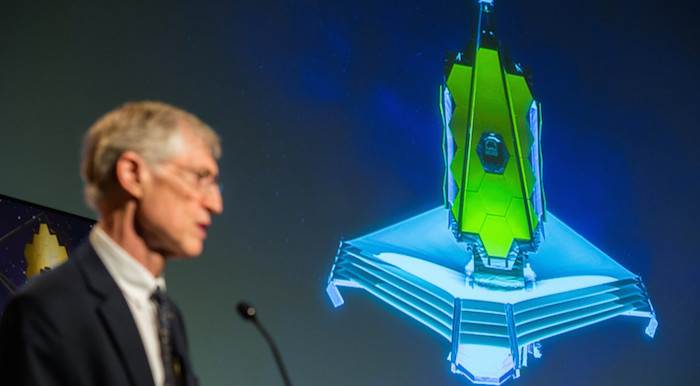.

JWST Program Scientist John Mather speaking at NASA Headquarters event in 2014 in front of an animation of the 6.5-meter infrared telescope. Photo Credit: NASA/Joel Kowsky
-
NATIONAL HARBOR , Md. — The James Webb Space Telescope’s Nobel Prize-winning head astronomer advised planetary scientists Nov. 9 to get started on proposals for focusing JWST’s 6.5-meter mirror on objects most closer to home than its usual cosmic quarry.
“Start negotiating your partnerships. This is going to take a while.”
“Just over two years from today, your proposals will be due,” John Mather, JWST program scientist at the Goddard Space Flight Center in Greenbelt, Maryland, said during a presentation at a JWST town hall gathering held here as part of the annual meeting of the American Astronomical Society’s Division of Planetary Sciences. “Start negotiating your partnerships. This is going to take a while. And you might even want to plan some supporting observations [with other telescopes] to demonstrate you’re the one who knows the most about your target.”
Mather, who shared the 2006 Nobel Prize in physics for his work on the Cosmic Background Explorer Satellite, said NASA in late 2017 will solicit its first round of JWST guest observer proposals — requests for telescope time from scientists other than the astrophysicists directly involved in the development of the roughly $9 billion infrared telescope mission.
JWST, slated to launch in late 2018 aboard a European Ariane 5 rocket, is designed primarily to observer faraway targets such as galaxies, nebulae and quasars.
However, JWST is also well suited to studying most targets in this solar system, with the exception of a few fast-moving comets and asteroids. Mars, one of the brightest objects in JWST’s field of view, might also be a challenging JWST target, said John Stansberry a scientist with the Space Telescope Science Institute in Baltimore, said at the town hall.
On the other hand, moons in the outer solar system, particularly icy ones such as Europa around Jupiter or Titan around Saturn, are promising targets. Kuiper Belt objects beyond Pluto’s orbit are also ripe targets, as are the giant gas planets of the outer solar system, Stansberry said.
“There’s a lot of interesting stuff you can do with the stratospheric chemistry of all the giant planets,” said Stansberry.
Mather said full JWST science operations will commence sometime in 2019 following a routine period of on-orbit checkout. Planetary Science proposals, like all JWST guest observer proposals, will be judged by an international committee consisting of U.S., European and Canadian scientists.
One outer-planets scientist who made an unscheduled stop at the podium during the JWST town hall agreed with Stansberry that JWST had plenty to offer non-astrophysicists.
“When I read about this telescope 15 years ago, I said ‘this is the telescope I need to understand upper-stratospheric chemistry in the outer solar system,’” said Heidi Hammel, executive vice president of the Association of Universities for Research in Astronomy in Washington. “If I want to do spatially resolved work at very high sensitivity in the far infrared to understand the chemistry and dynamics of Uranus and Neptune, for example, I have no other facility that’s going to be able to do it.
Neptune and Uranus have been probed by a NASA spacecraft only once: Voyager 2 blazed by the icy giants in 1986 and 1989, respectively. This summer, NASA started studying whether it could mount a mission to either Uranus or Neptune for roughly $2 billion, but that is a long way from a funding commitment. Even if the mission were approved, it would not launch until the late 2020s or 2030s, Jim Green, NASA’s planetary science director, said in August.
Besides JWST, “there’s no other way” to study either Uranus and Neptune, at least for the foreseeable future, Hammel said. “This is it. This is the only tool I have.”
Quelle: SN
5838 Views
